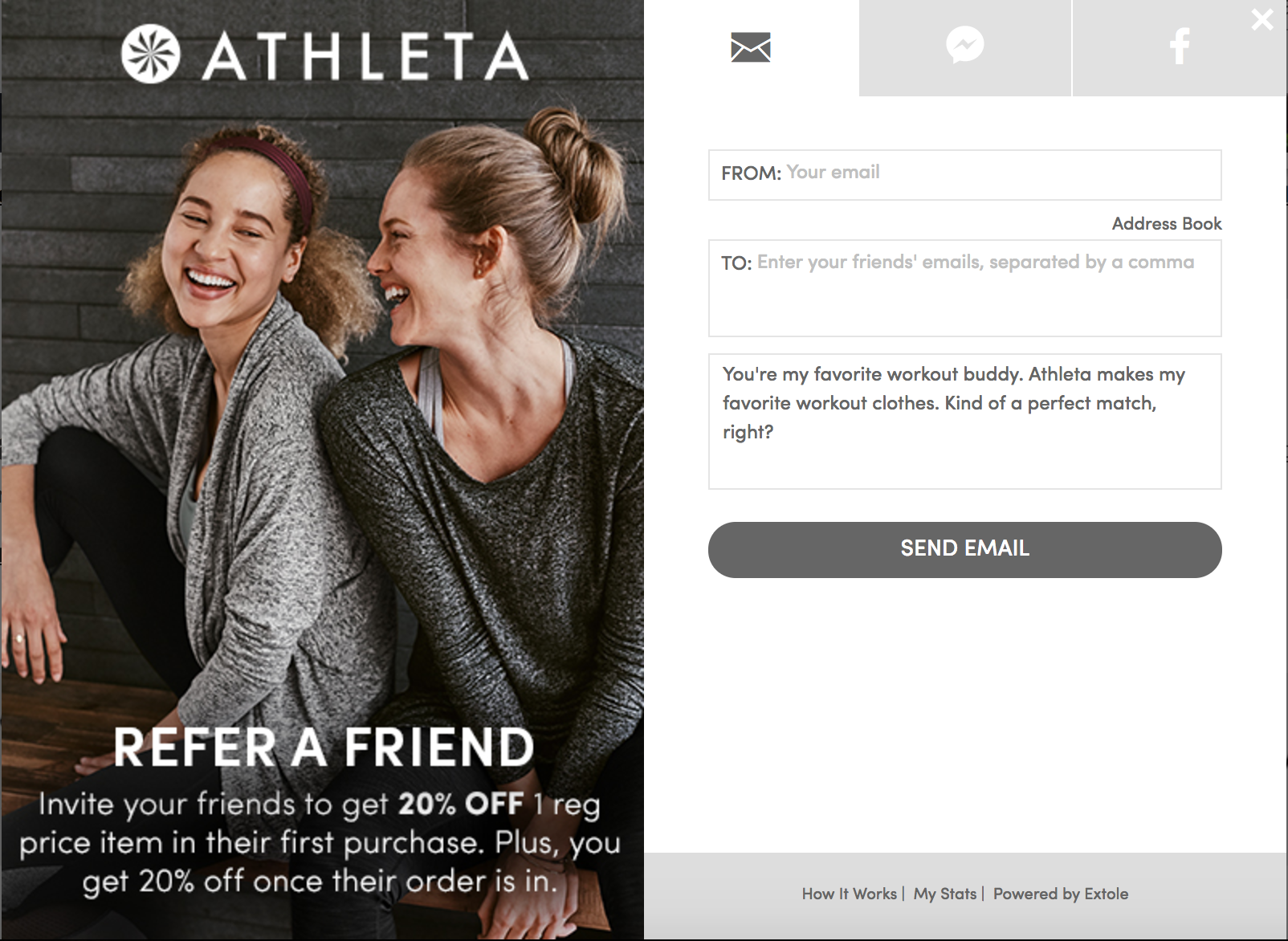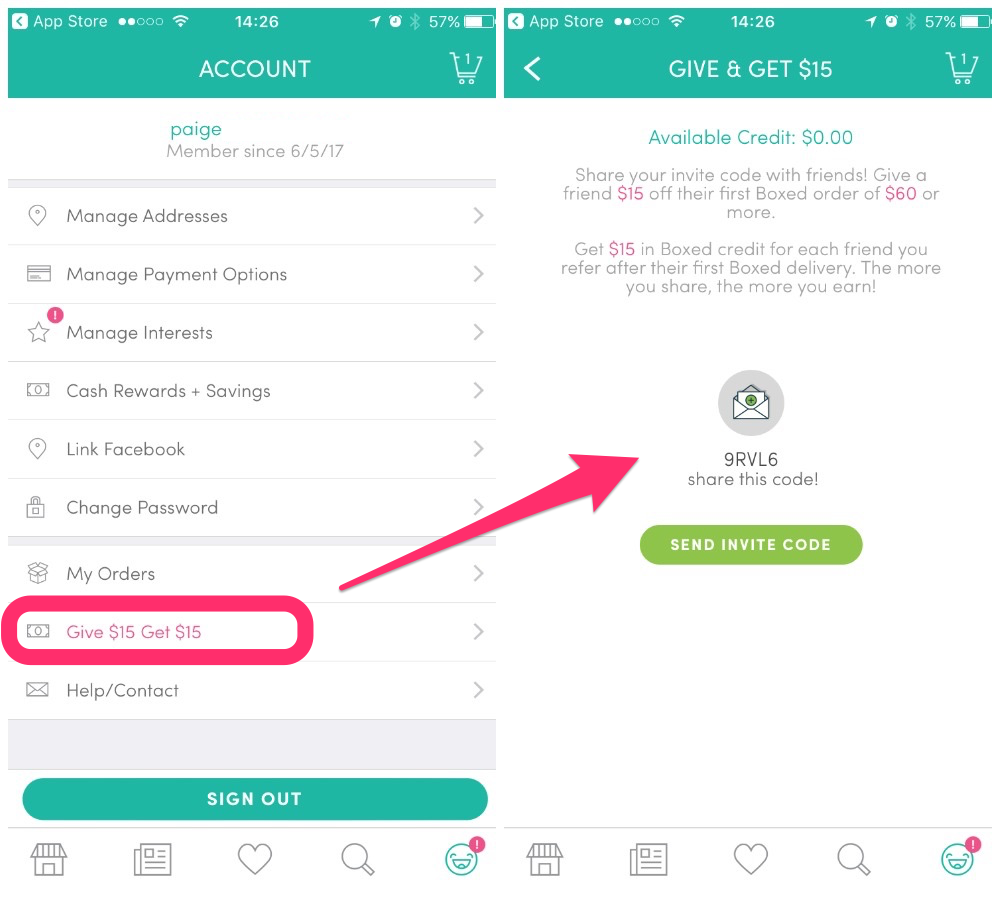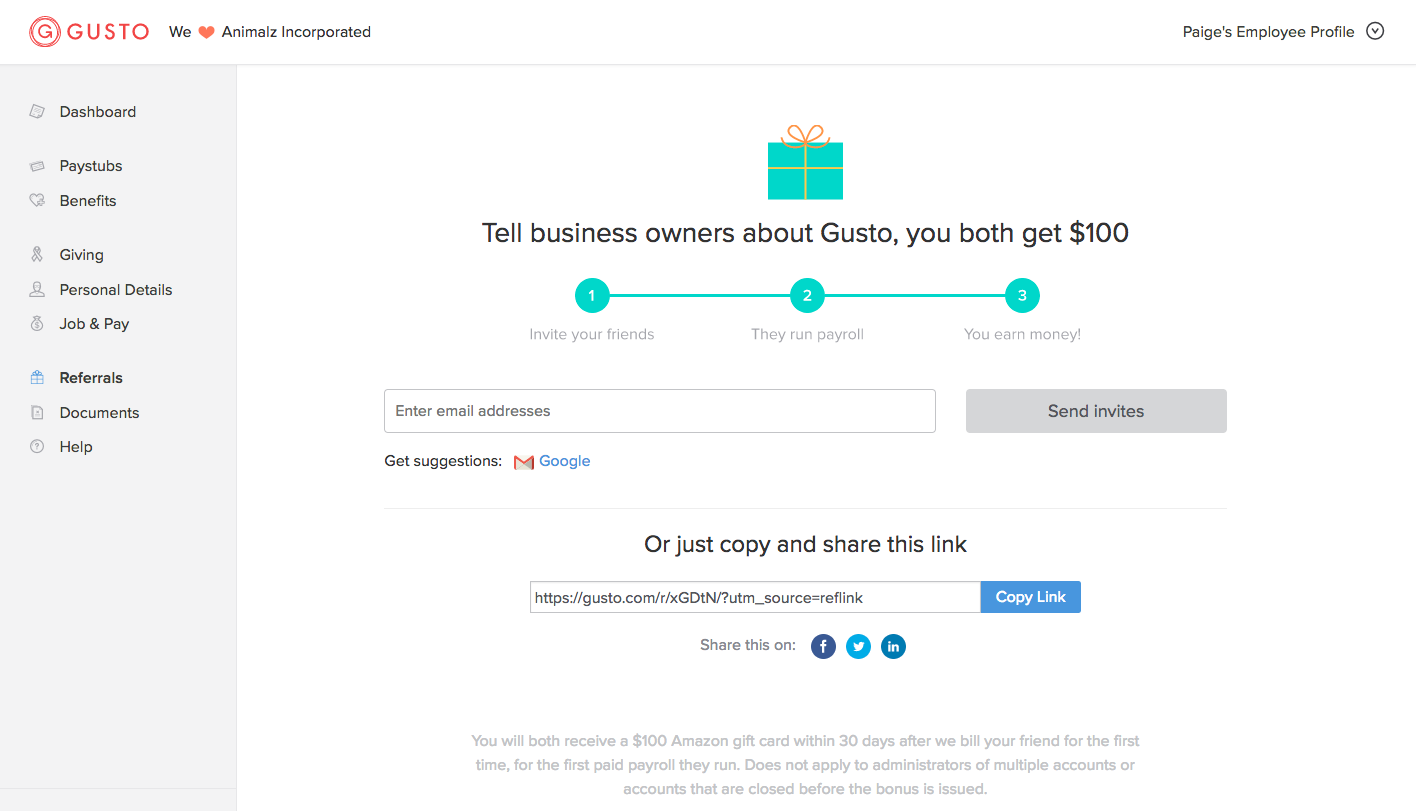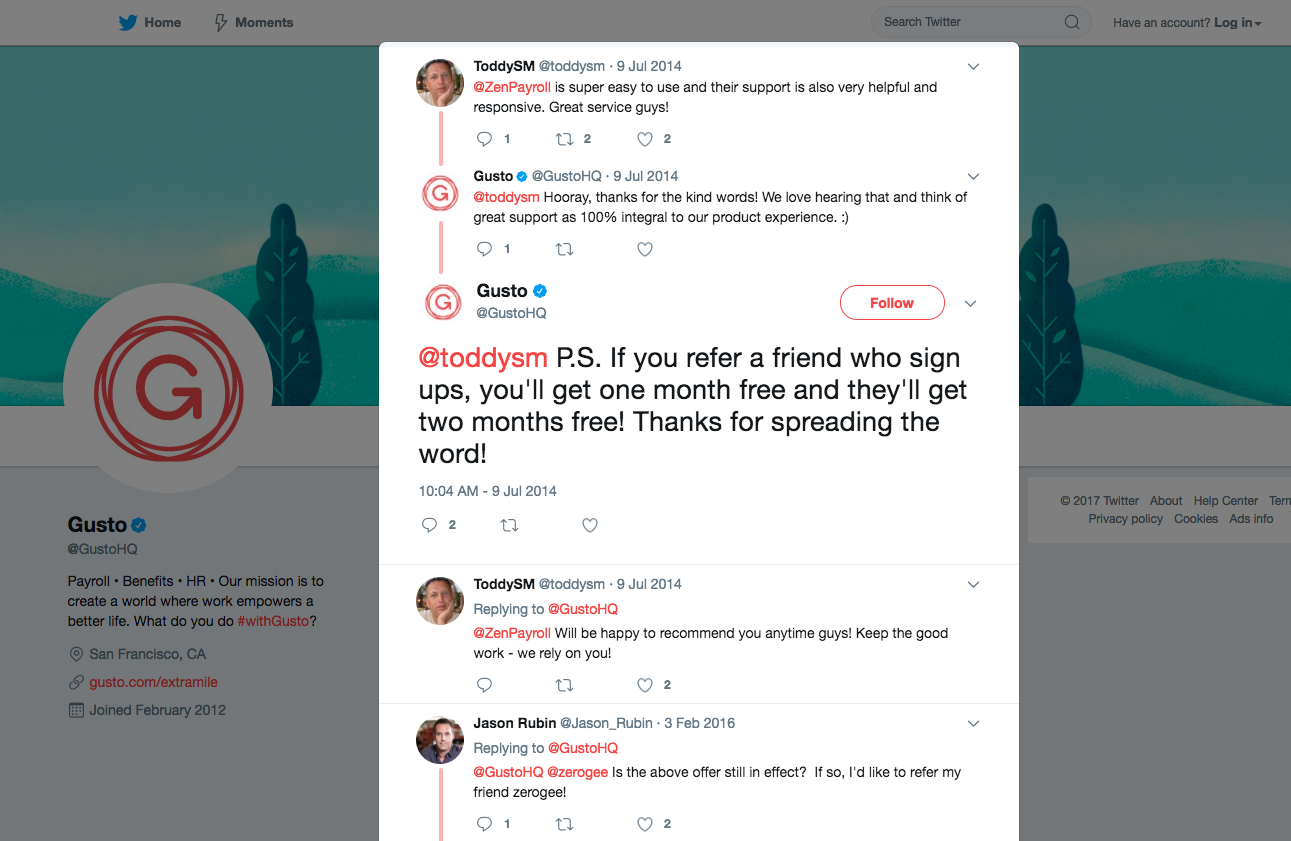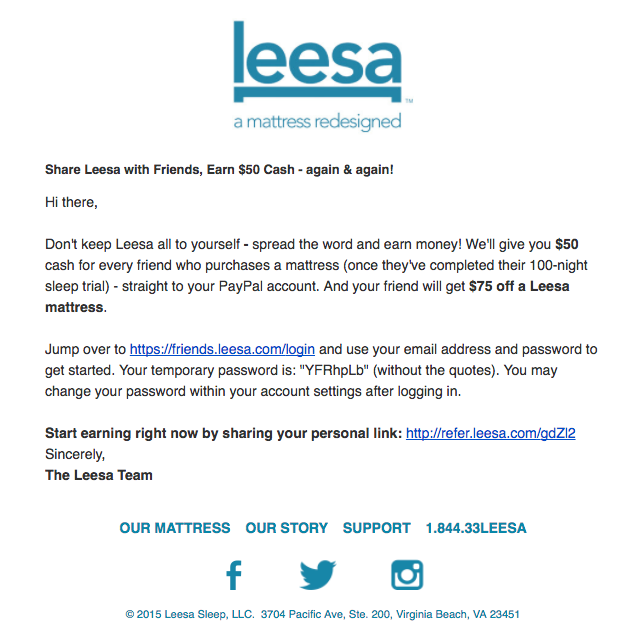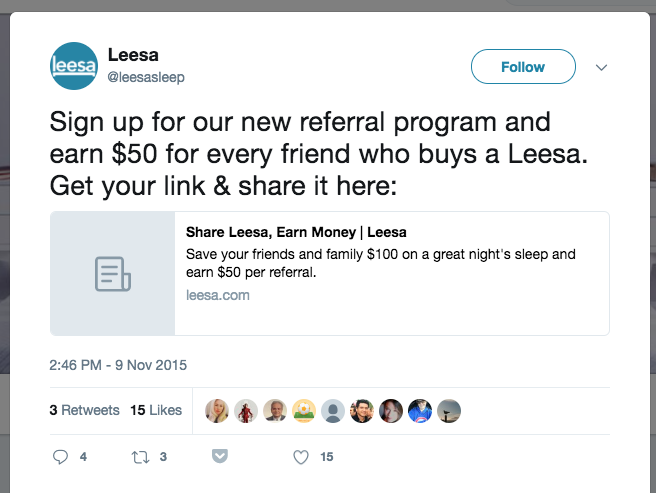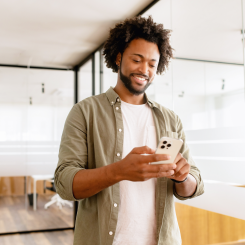There’s no denying the power of referral marketing. People are 4x more likely to buy something when a friend refers them. It’s because there’s an existing relationship there, built on trust.
Today, people don’t just talk about and refer your brand through word-of-mouth. They share on social media, they email, they text. Creating an omnichannel referral strategy helps you connect to your customers consistently, wherever they are.
For example, someone might see your referral program in your store, email it to a friend, who then opens it on their laptop. By making that experience as seamless as possible you boost your chances of getting in front of more people than you would have otherwise.
This strategy works because 60% of people online “start shopping on one device but continue or finish on a different one.” The opportunity to refer friends follows them.
Omnichannel referrals give a personalized brand experience and incentivize people to share with friends across multiple channels.
Let’s take a look at examples of companies that have adopted omnichannel referral marketing and how they use it. We’ll share the strategies they use and what you can do to boost your efforts.
Increase referrals by expanding exposure
Acorns is a micro-investment platform. With it, users don’t have to squirrel away savings or cut their expenses to invest large chunks of money. Instead, they spend the way they normally would, with one exception. When they use their debit or credit cards, Acorns rounds off the change and invests the difference for them. Users don’t have to think about it, it’s done automatically for them.
Their omnichannel approach focuses on helping users accelerate their investments with online referrals. Driving customer acquisition across email marketing and Twitter allows Acorns to expand their reach and widen their referral funnel.
Acorns’ referral program
Every single email Acorns sends to users includes a referral offer in the footer. For example, they recently sent an email asking users to contribute to a Hurricane Harvey relief fund. The footer included the offer, “Give $5, Get $5” for any users who referred friends.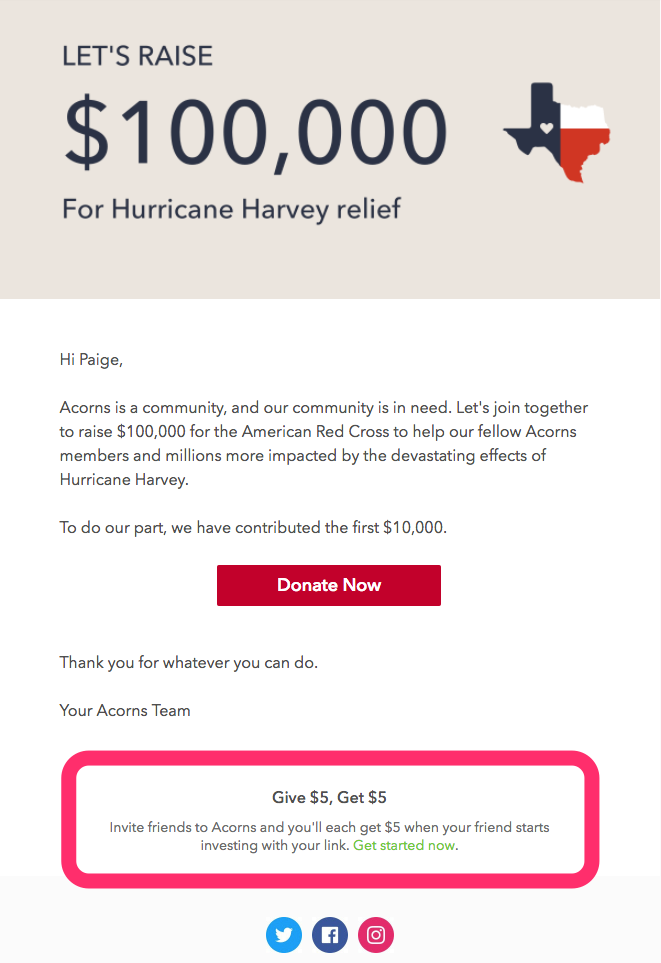
When they click on the link they’re taken to a landing page where they get a personal link to forward their friends. Users can also get the link when they log onto the website. The same offer pops up when they access the referral page.
When new users sign up through the app, they’re sent a push notification almost immediately. Again, the offer is the same but the difference is that a sense of urgency is added. For example, users can get $5 for every friend they invite and who invest in a given month.
For users on Twitter, Acorns regularly offers referral opportunities to followers. To celebrate Financial Literacy Month, they offered a new incentive. Users who invited friends could get $10 in their account. This was up from the usual $5.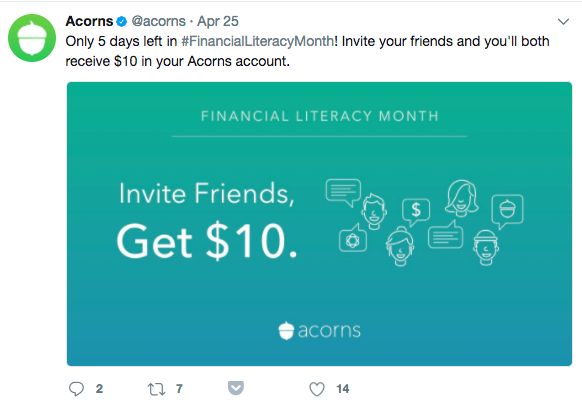
Acorns takeaways
By increasing exposure to your referral program, across different channels, you increase the number of people who go on to make a referral. Figure out the details of the offer and make it compelling. If you want your referrals to get people sharing more, use special occasions as a chance to give bigger, one-off referral incentives. For example, for their anniversary, Acorns offered users $200 when they referred 10 friends during the month.
Use purchase touch points to promote referrals
Athleta is a women’s athletic wear company. They cater to a wide range of women, which has made their brand appealing to lots of women. Their brand focus is creating a supportive community for women and healthy living. To help, they offer a brand ambassador program meant to inspire and motivate women.
They offer both ecommerce and in-store referral channels for customers, which includes both online and offline referrals. This means, customers who get an email with a link to share savings with friends, will also see the same thing in-store. For example, at checkout their receipt might say something like, “Want to save more? Log onto our website to get your personal code and start referring your friends.” The offline customer experience drives online referrals.
At the end of every touch point – like a comment from a sales person, a receipt or an email confirmation – Athleta is there encouraging people to refer with a code or a “Forward this email” call-to-action.
athleta’s referral program
When users click on the refer a friend link on the homepage, a pop-up message detailing the program appears.
From here, users can send a link to their friends by email or share it via Facebook or Facebook Messenger. When users invite friends, they get 20% off when a referral uses their personal link to save 20% on an item.
When the referral’s complete, the sender gets an email from Athleta thanking them for sharing. The email also confirms that they’ll be notified when their friend completes their purchase. Also included in the thank you email is a call-to-action to share with more friends.
Altheta also drives traffic to their website with email campaigns. In one campaign, customers were given the option to refer a friend so they could save $15 on purchases over $100. Customers who followed through and referred someone also got the same offer. This campaign helped the company engage customers across multiple channels. Instead of waiting for customers to go to their website and shop online, the email was a starting point to drive subscribers to the online store.
Also, the email campaign tied back to the brand’s focus of empowering women. They included #PowerOfShe with links to their social media accounts.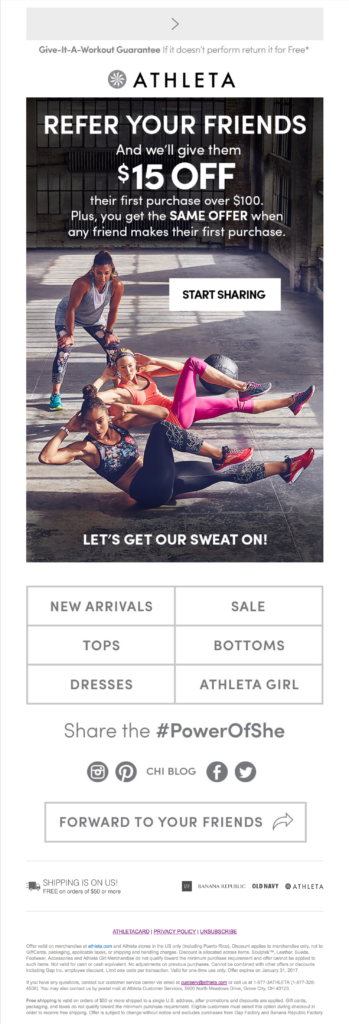
Athleta takeaways
Whatever your brand focus is, it should be explained throughout your referral program. Athleta shares social media links in all of its communications with customers. Even though social media is just one channel, breaking down the different platforms is another way to get more exposure.
Plus, most of the graphics they use, whether on their website or in their emails, focus on women exercising and having fun. Successful omnichannel referrals use similar images and messages across channels so that there’s cohesion and clarity.
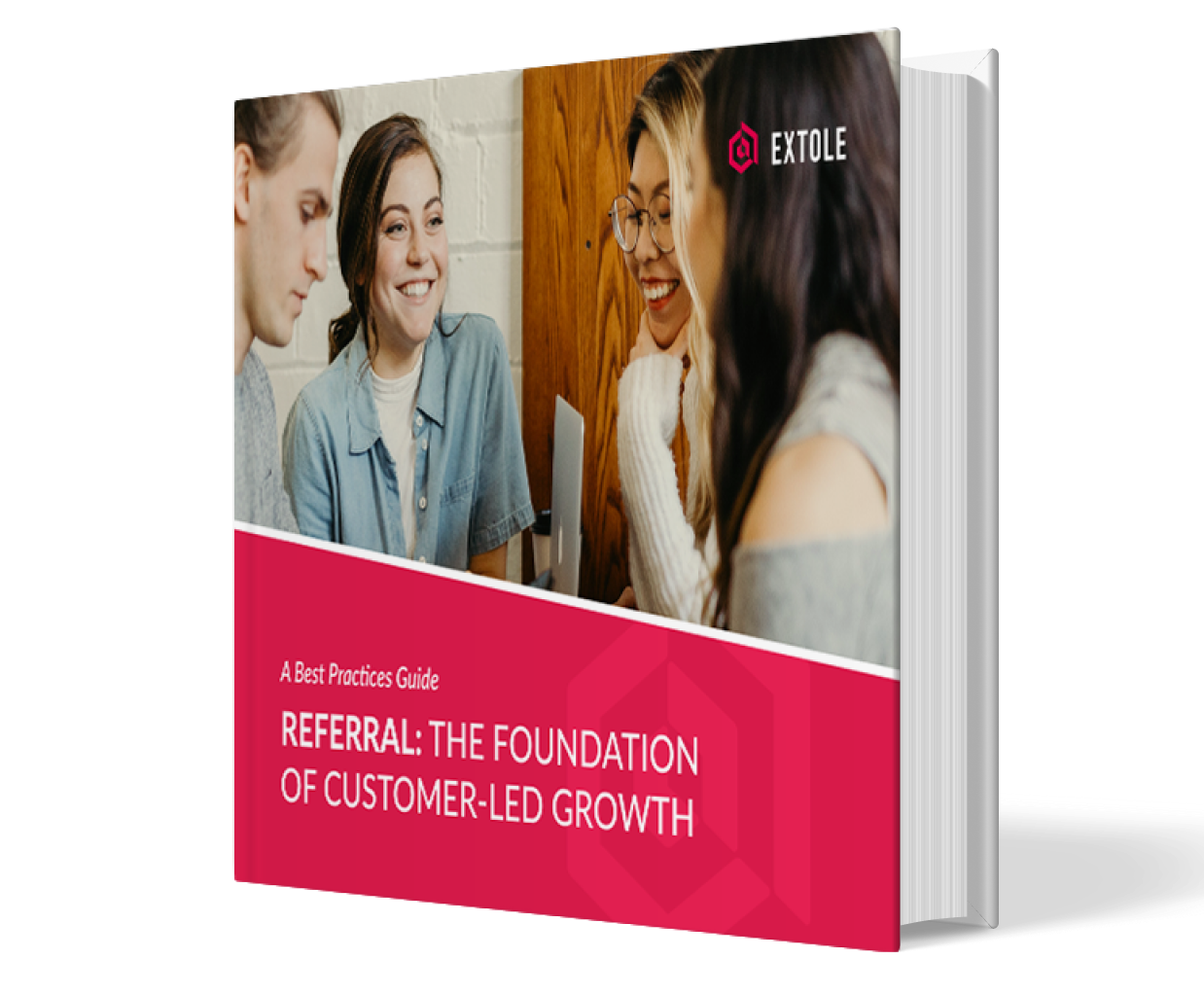
Referral Marketing – The Best Practices You Need to Know
Written by veteran referral marketers, this guide will help you optimize your referral marketing program and supercharge growth.
Get the GuideLink referral sharing with social media sharing
Boxed is a bulk shopping platform that lets users shop online for everyday household items. They recognize the importance of convenience and offer customers an ecommerce solution.
Because they’re an ecommerce platform, their referral program uses multiple online referral channels. They use their mobile app, email campaigns and social media to promote customers sharing the goodness of the box with friends. Facebook is an especially strong channel to promote their referrals and encourage people to like and share the service because it spreads their reach to include their customers’ friend networks.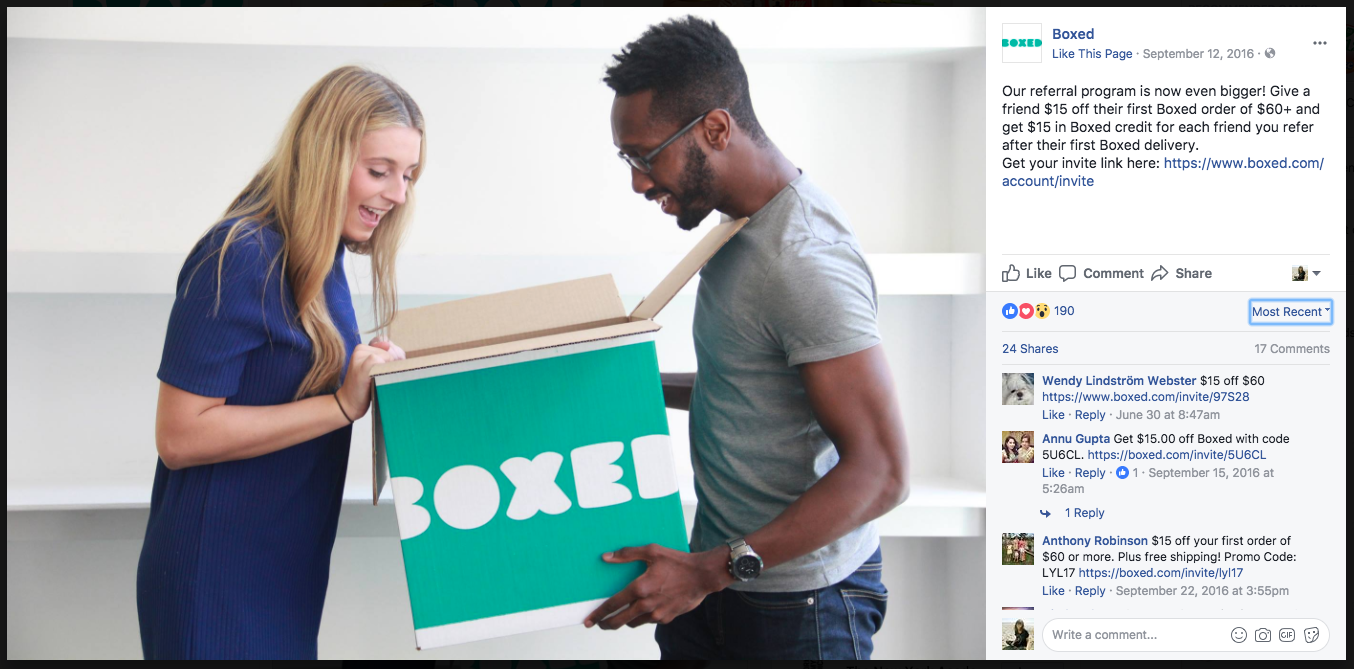
boxed referral program
They offer a standard program which lets users give friends $15 off their first Boxed order over $60. In return, users get $15 in credit for every friend they refer.
When users download and open the mobile app and access the home screen, they have to click on the laughing emoji at the bottom right of the page. This takes them to their account menu where they click on “Give $15, Get $15.” They’re taken to a referral page that explains how to send an invite code.
On the Boxed Facebook page, they offer followers the chance to take part in the referral program. Once followers click on a link and sign up, they’re given the option to immediately share the savings with friends. Their email campaign is similar. Every email they send has a reminder to refer a friend at the bottom. When subscribers click on it, they’re given a personal invite code to send to friends.
boxed takeaways
Choose a theme to emphasize and make sure your graphics and messaging support it. Boxed uses phrases like, “sharing is caring” to go with people opening boxes together. If you’re using strictly online referral channels, link back to one source. For example, when you send emails or post to Facebook, also include a link back to the referral page of your website. It’s like a one stop shop for all your channels where customers can monitor their referrals.
Personalize referrals to engage customers
Gusto offers a cloud-based payroll, benefits, and human resource management platform for small businesses. Their omnichannel referrals are available strictly online and are personalized using Twitter and customer support.
gusto’s referral program
When users refer a friend to Gusto and they sign up, they both get $100.
In any email Gusto sends to users, they include a link at the bottom that lets subscribers submit emails of friends they’d like to refer. They simply click on the “Refer a friend to Gusto” call-to-action in the email and they’re taken to a landing page to enter the email addresses.
For Twitter referrals, Gusto takes a more personal approach. When followers mention them, they not only respond directly but they also offer a discount for referrals. For example, they might offer one month free to the referrer and two months free to anyone they refer and creates an account.
Finally, they use their blog to announce special referral programs. They use this type of post to encourage new users to sign up so that they can take part in the referral program and save.
gusto takeaways
Get creative with how you promote your referrals across multiple channels. In addition to the standard offer you promote, recognize customers by offering a customized referral offer. Do this on one channel or across all of them depending on how active customers are. Decide what customer actions will trigger the referral. For example, when customers reach a milestone like 10 referrals, give them a bonus that lets them share with friends using different channels. This helps position your brand as one that puts the needs of customers first.
Use social proof to accent referrals
Leesa is a leader in the ecommerce mattress space. They’re a CPG-direct to consumer company using cost-effective marketing strategies like referrals across channels to lower customer acquisition costs and expand. They even offer an indirect incentive. When they sell 10 mattresses, they donate one to a shelter. So far they’ve donated over 17,000 mattresses. Even though their focus is online referrals, customers can see the result of their support offline.
For example, they do a lot in the communities they work in and use Twitter to promote that work. It shows customers and their referrals how their purchase will help people in need. This means, the more referrals customers make, the more mattresses Leesa can donate. This positions them as a brand that’s committed to supporting communities and focusing on environmental causes.
Leesa’s referral program
For their referral program, customers save $50 when they give a friend $100 off their purchase. To promote their program, Leesa uses email, social media and their website.
A few months after customers buy their new mattress, Leesa sends them an intro email for the referral program. In the email, they offer a link that lets customers log into their account to send the referral. They also offer a second option where customers can send a link directly to their friends to use.
When they first launched their referral program, they announced them on Facebook and Twitter. They gave followers the option to click through a link to get to the referral landing page.
This meant anyone interested had to create an account if they weren’t already a customer. It helped drive interest in the brand and boosted their lead generation.
For users who are ready to buy but still looking for more information, they can join the referral program from Leesa’s home page.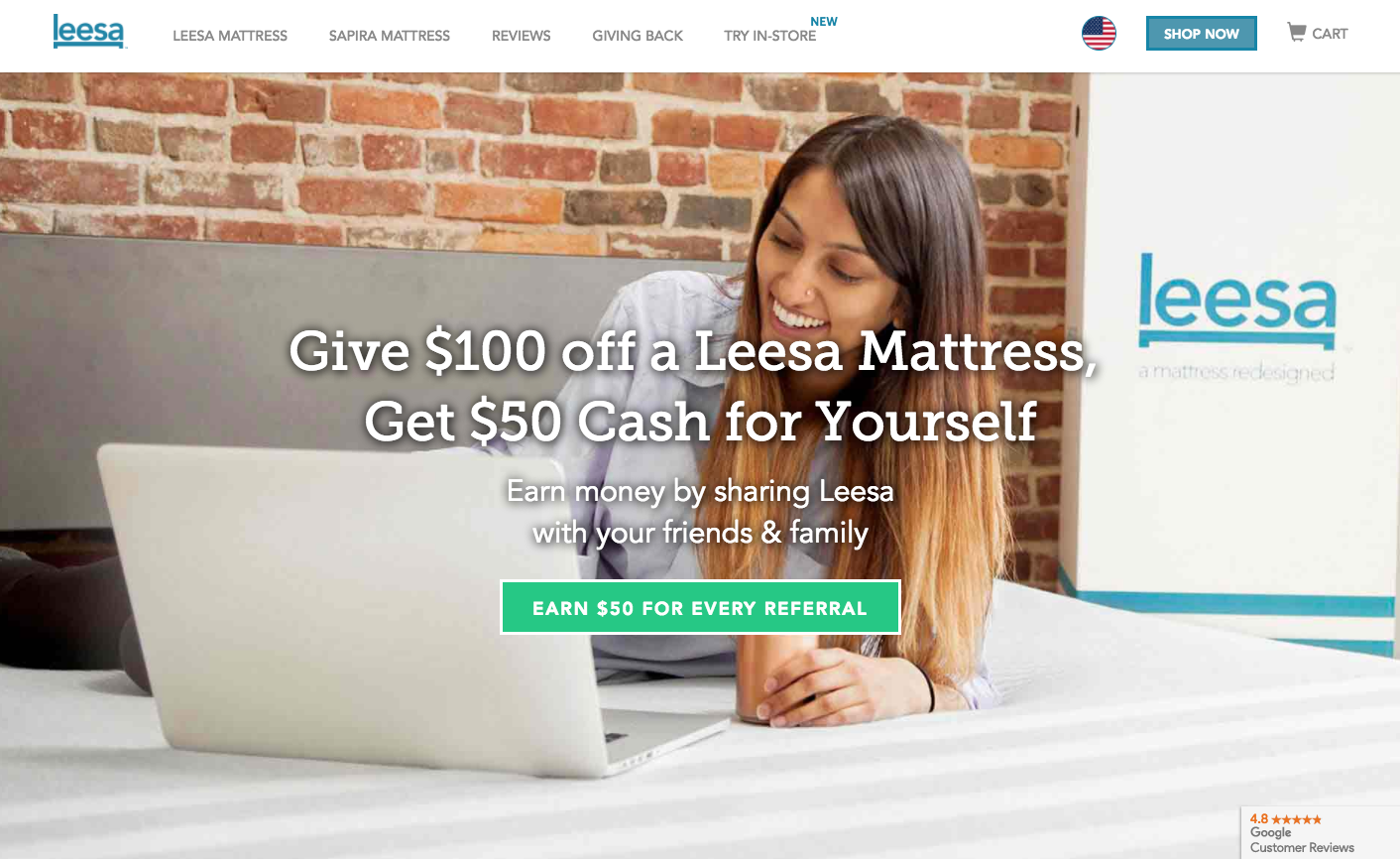
leesa takeaways
You don’t have to rush into offering your referral program. Leesa gives customers time to get comfortable with the product before introducing their program. Customers are more likely to be active ambassadors and advocates for the program because they have first-hand experience. And it appears to be working. Over 3,000 people have registered as ambassadors for the referral program. Plus, 33% of Leesa’s sales come from referrals.
Building your referral program
The first step in building a successful program is to be clear on what message you want your brand to communicate. Are you focused on improving communities, empowering people or making processes easier? Whatever it is, this theme has to carry through all channels so that it’s clear to customers what they’re supporting.
Next, create a core program that focuses on a quick and simple way for customers to save. Something like, “Give $10, Get $10” is easy to remember and follow-through on. It also helps to give a little extra incentive for customers to embody the mindset of brand advocates. If they comment on your blog or share your benefits – in addition to referrals – on social media, offer them a personalized referral.
Finally, focus on the channels where your customers spend the most time. That’s the beauty of omnichannel referrals, you go where your customers go. Choose the ones where you see the most engagement. Do your emails have high open rates or do you have active Facebook followers that comment on and share your content? Focus on these channels to get the most exposure.
